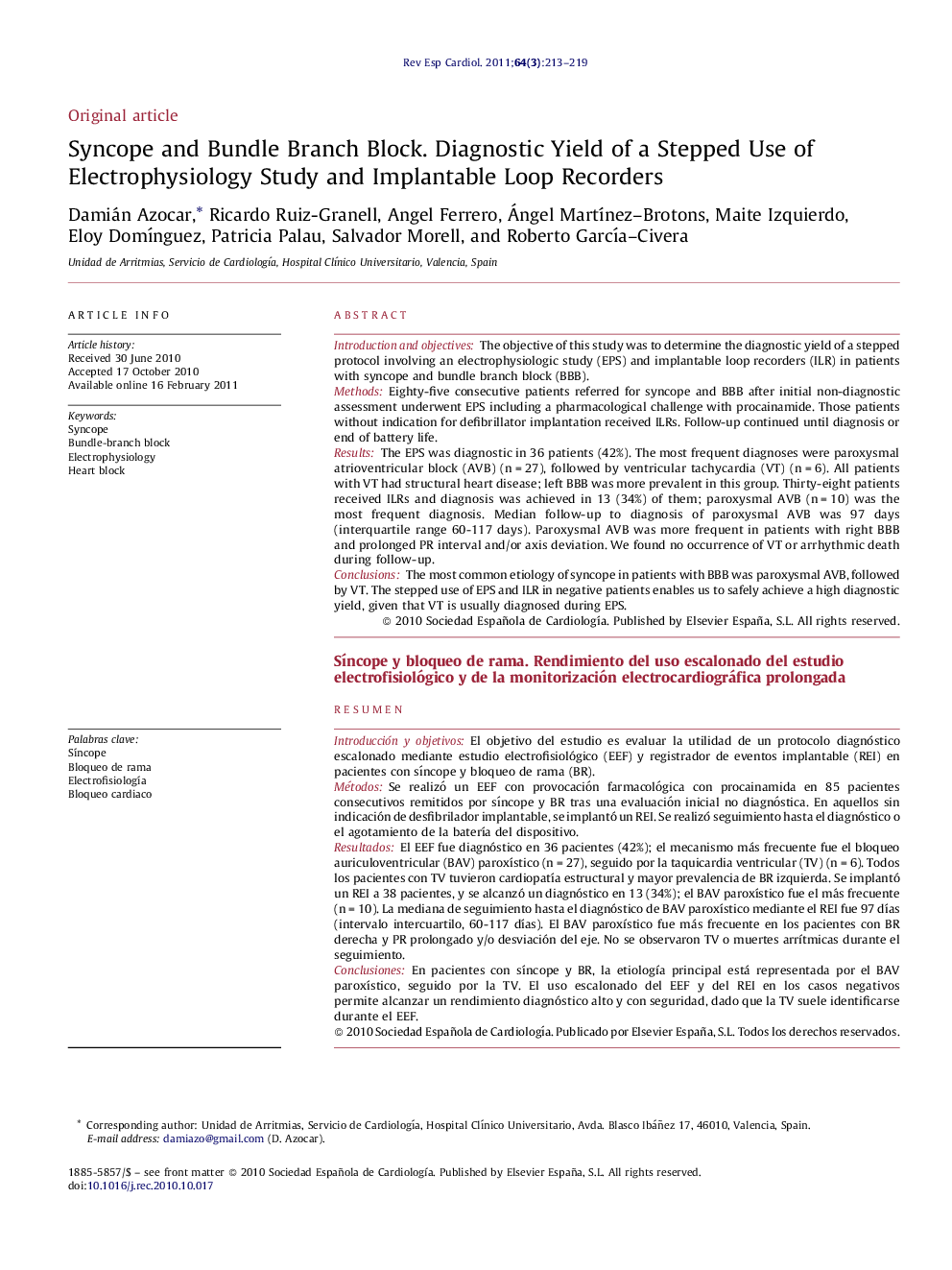| کد مقاله | کد نشریه | سال انتشار | مقاله انگلیسی | نسخه تمام متن |
|---|---|---|---|---|
| 3018331 | 1182166 | 2011 | 7 صفحه PDF | دانلود رایگان |

Introduction and objectivesThe objective of this study was to determine the diagnostic yield of a stepped protocol involving an electrophysiologic study (EPS) and implantable loop recorders (ILR) in patients with syncope and bundle branch block (BBB).MethodsEighty-five consecutive patients referred for syncope and BBB after initial non-diagnostic assessment underwent EPS including a pharmacological challenge with procainamide. Those patients without indication for defibrillator implantation received ILRs. Follow-up continued until diagnosis or end of battery life.ResultsThe EPS was diagnostic in 36 patients (42%). The most frequent diagnoses were paroxysmal atrioventricular block (AVB) (n = 27), followed by ventricular tachycardia (VT) (n = 6). All patients with VT had structural heart disease; left BBB was more prevalent in this group. Thirty-eight patients received ILRs and diagnosis was achieved in 13 (34%) of them; paroxysmal AVB (n = 10) was the most frequent diagnosis. Median follow-up to diagnosis of paroxysmal AVB was 97 days (interquartile range 60-117 days). Paroxysmal AVB was more frequent in patients with right BBB and prolonged PR interval and/or axis deviation. We found no occurrence of VT or arrhythmic death during follow-up.ConclusionsThe most common etiology of syncope in patients with BBB was paroxysmal AVB, followed by VT. The stepped use of EPS and ILR in negative patients enables us to safely achieve a high diagnostic yield, given that VT is usually diagnosed during EPS.
ResumenIntroducción y objetivosEl objetivo del estudio es evaluar la utilidad de un protocolo diagnóstico escalonado mediante estudio electrofisiológico (EEF) y registrador de eventos implantable (REI) en pacientes con síncope y bloqueo de rama (BR).MétodosSe realizó un EEF con provocación farmacológica con procainamida en 85 pacientes consecutivos remitidos por síncope y BR tras una evaluación inicial no diagnóstica. En aquellos sin indicación de desfibrilador implantable, se implantó un REI. Se realizó seguimiento hasta el diagnóstico o el agotamiento de la batería del dispositivo.ResultadosEl EEF fue diagnóstico en 36 pacientes (42%); el mecanismo más frecuente fue el bloqueo auriculoventricular (BAV) paroxístico (n = 27), seguido por la taquicardia ventricular (TV) (n = 6). Todos los pacientes con TV tuvieron cardiopatía estructural y mayor prevalencia de BR izquierda. Se implantó un REI a 38 pacientes, y se alcanzó un diagnóstico en 13 (34%); el BAV paroxístico fue el más frecuente (n = 10). La mediana de seguimiento hasta el diagnóstico de BAV paroxístico mediante el REI fue 97 días (intervalo intercuartilo, 60-117 días). El BAV paroxístico fue más frecuente en los pacientes con BR derecha y PR prolongado y/o desviación del eje. No se observaron TV o muertes arrítmicas durante el seguimiento.ConclusionesEn pacientes con síncope y BR, la etiología principal está representada por el BAV paroxístico, seguido por la TV. El uso escalonado del EEF y del REI en los casos negativos permite alcanzar un rendimiento diagnóstico alto y con seguridad, dado que la TV suele identificarse durante el EEF.
Journal: Revista Española de Cardiología (English Edition) - Volume 64, Issue 3, March 2011, Pages 213–219